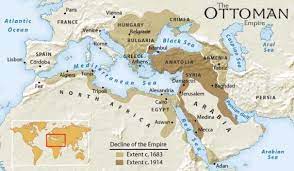In the early 16th century, the Ottomans conquered Palestine, which had witnessed several conflicts throughout history.
Syria and Palestine became Ottoman territory after Yavuz Sultan Selim defeated Mamluk ruler Kansu Gavri at the Battle of Marj Dabiq in 1516. On December 29, 1516, Yavuz Sultan Selim entered Jerusalem. Palestinian area was divided into three states under Ottoman rule: Jerusalem, Gaza, and Nablus, all of which were linked to the Damascus Province. During the Ottoman Empire's final years, Palestine was initially linked to the state of Sidon, then to Syria, and finally to Beirut, which was formed during that time.
For 401 years, the Ottomans governed Palestine. Palestine was and continues to be an important region for Jews & Christians who believe that the Temples stood on Mount Moriah, on top of what is known as the 'Foundation Stone.' In this location, Abraham set out to sacrifice Isaac in the famed test of faith God had given him.
Some Muslims believe that the 'Al Aqsa mosque' (literally translated as "the farthest place of prayer") that is named in the Quran from where Muhammad took his 'Night Journey' is located in the same complex that housed the Jewish Temples. Many believe that the mosque on the Temple Mount today could not be the one mentioned in the Quran as Islam had only spread to the region after Muhammad's time. Islamic liturgy written several hundred years after Muhammad's time mentions Jerusalem as the location of their prophet's ascension to heaven. However, this is widely seen by many in the Judeo-Christian tradition as a way to justify the occupation of the famous Jerusalem mountain by associating it with Muhammad and legitimizing Islam as the new incarnation of the Abrahamic faith, thus delegitimizing the Christian and Jewish claim to the land.
During the Ottoman reign, the hallowed sites in Palestine, and Jerusalem in particular, could not be shared. Even the various Christian denominations were at odds with one another. The Ottoman Empire used its own administrative practices in Palestine after conquering the country, and the Ottoman administration ruled the territory. The Ottomans maintained the administrative and political organization that the Mamluks left in Palestine. Greater Syria became an eyalet (province) ruled by Damascus, while the Palestine region within it was divided into the five sanjaks of Safad, Nablus, Jerusalem, Lajjun, and Gaza. The sanjaks were further subdivided into subdistricts called nawahi.
For much of the 16th century, the Ottomans ruled Damascus Eyalet in a centralized way. The Istanbul-based Sublime Porte (imperial government) played a crucial role in maintaining public order and domestic security, collecting taxes, and regulating the economy, religious affairs, and social welfare. In the early years of Ottoman control, most of Palestine's inhabitants, estimated to be over 200,000, resided in villages. Gaza, Safad, and Jerusalem were the three largest cities, each having a population of 5,000–6,000 people. At the time of the Battle of Yarmukh, when the Levant passed under Muslim Rule, thirty Jewish communities existed in Haifa, Shechem, Hebron, Ramleh, Gaza, Jerusalem, and many other cities. Safed became a spiritual center for the Jews, and the Shulchan Aruch was compiled there along with many Kabbalistic texts.
After the expulsion of Jews from Spain during the Inquisition, the Ottomans, under the rule of Beyezid II (Ottoman ruler from May 22, 1481 - April 24, 1512), provided asylum for many of them in Palestine as well as other areas under their control that was home to a Jewish population. Although the treatment of Jews under the Ottoman Empire may have been exaggerated, there was obvious tolerance. Non-Muslims were organized into independent groups based on religion under the millet system. The millet provided Jews with significant administrative autonomy, which was represented by the Hakham Bashi, the Chief Rabbi. There were no limits on the kind of occupations that Jews might pursue, such as those found in Western Christian countries. However, there were restrictions on where Jews may live and work, which were comparable to those imposed on Ottoman subjects of other religions.
Jews, like all non-Muslims, were subjected to haraç ("head tax") and other restrictions on attire, horseback riding, army duty, residential location, and slave ownership, among other things. Even though many of these prohibitions "were decreed [and] were always enforced," some Jews rose to positions of power in the Ottoman world. Specifically, Mehmed II's minister of finance, Hekim Yakup Pasa, his Portuguese physician Moses Hamon, Murad II's physician Ishak Pasha, and Abraham de Castro, the master of the mint in Egypt, are among the Jews who rose to high positions in the Ottoman court and government.


